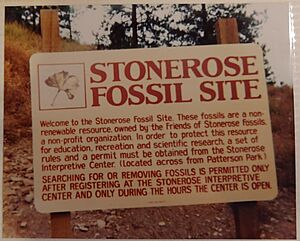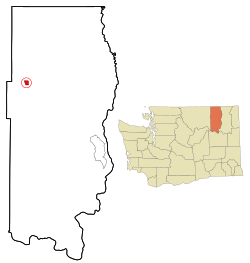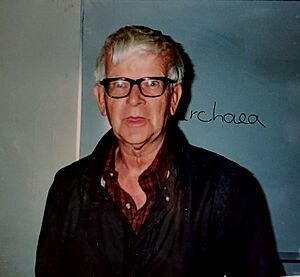Stonerose Interpretive Center facts for kids

Sign at Boot Hill 1992
|
|

Location of Republic, Washington
|
|
| Named after | Rose family fossils found at the site |
|---|---|
| Founded | 1989 |
| Founder | Wes Wehr, Bert Chadick, Madeline Perry, Gary Anderson, Richard Slagle, Klifton Frazier |
| Legal status | 501c(3) |
| Focus | Eocene fossils of Northern Ferry County |
| Location |
|
|
Key people
|
Solea Kabakov, Director Travis Wellman, Operations Manager |
|
Parent organization
|
Friends of Stonerose Fossils |
|
Employees
|
3 |
| Website | https://stonerosefossil.org/ |
The Stonerose Interpretive Center & Eocene Fossil Site is a special museum and fossil dig in Republic, Washington. It's a non-profit organization, which means it helps the public and doesn't make money for private owners. The center started in 1989. It's home to amazing fossils that have even been shown in famous magazines like National Geographic Magazine and Sunset magazine.
Discovering Ancient Life: The Stonerose Story
The first fossil site was found in 1977 near Republic, Washington. An artist named Wesley "Wes" Wehr and a high school student, Kirk Johnson, made the discovery. They found ancient plant and insect fossils.
Wes Wehr and a city council member, Bert Chadick, later had an idea. They thought a public center where people could dig for fossils would be great. It could also help the local economy. They wanted to show that important science could happen anywhere.
The city of Republic helped buy a house for the center. They also funded positions for people to work there. In 1987, Madilane Perry became the first curator. A curator is someone who manages a museum's collections.
The old house needed some work, like adding glass cases for the fossils. The center officially opened in August 1987. It was named "Stonerose" because of the rose family fossils found in the rocks.
Later, a bigger and easier-to-reach fossil site was found. In 1989, a group called Friends of Stonerose Fossils was created. This non-profit group helps support the center. They even held a seminar for teachers to learn how to use fossils in their classrooms.
The center moved to a new house across from the city park. This house was expanded in 1996. Through fundraising, the Friends of Stonerose Fossils bought land around the "Boot Hill" site. This site has about 100 feet of exposed fossil layers.
In 1995, over 9,000 people visited the center. That was more than the entire population of Ferry County that year! By 2014, the center was seeing about 6,000 visitors each year. Over 120,000 people have visited since it opened.
In 2019, the center started planning to move again. They raised money to buy a 4,000 square foot building on Clark Avenue. This is the city's main street. By early 2020, they had raised over $20,000. This allowed them to buy the building.
Today, the fossil site is a short walk from the center. Visitors can get a permit to dig for fossils. You can keep a few small fossils you find. However, important or rare finds stay with the center. These special fossils are added to a database. The finder's name is always recorded with the fossil. The center even asks that finders be recognized in scientific papers. Some new species have even been named after the people who found them!
Ancient Earth: The Geology of Stonerose
The Stonerose fossil beds are from the Eocene Epoch. This was about 51 million years ago! At that time, the area where Republic is now was an ancient lake. The bottom of this lake was made of volcanic ash.
This ash hardened into a type of rock called shale. This shale is very fine-grained and holds amazing fossils. These fossils include many extinct insects, fish, leaves, and even bird feathers.
These fossil beds are very important. They hold the earliest known records of the Rosaceae (rose family) and Aceraceae (maple family). Since the Republic fossil beds were rediscovered, more than 200 different species have been found there.
Incredible Finds: Fossils at Stonerose
The Eocene fossil sites in Republic are part of a larger group of ancient lake beds. These beds stretch north into British Columbia, Canada. They include other famous sites like the Princeton Chert and McAbee Fossil Beds. These sites all have many fossil plants, insects, fish, and other ancient life.
The current logo for Stonerose is a fossil of Florissantia quilchenensis. This was a flower from an extinct relative of the cocoa plant. Lisa Barksdale, a former Stonerose curator, and Wes Wehr found it. This fossil was featured in National Geographic Magazine in July 2002.
The center's fossil collections include many published specimens. For example, they have several rare Dillhoffia cachensis fruits. The fossils and the center have also been part of a traveling exhibit. This exhibit, called "Cruisin’ the Fossil Coastline," highlights the fossil history of the West Coast.



